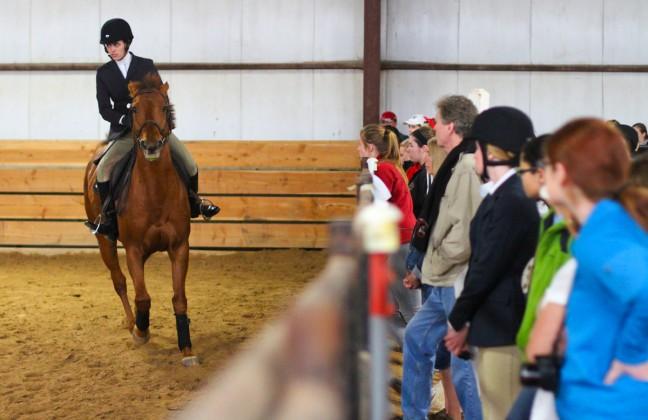At Mandt Equestrian Center, 20 minutes south of campus in Oregon, Wis., there is a shallow bank of metal folding chairs set on top of the hard-packed dirt flooring a cavernous barn. To the right of the seats, two horses and several people are sequestered, clearly waiting for their chance to enter the main arena. Most of the barn has been set off for that purpose. Fences and gates are arranged in careful alignment around the center of the arena; to the right of the room, an announcer sits with several judges.
The set-up is for intermediate fences, one of a handful of competitions that will be scored during the course of the event. On this particular day, the University of Wisconsin’s equestrian team has plans on moving through their region and taking on the next level of competition.
Equestrian team captain Shannon Roska, a UW senior with plans for a graduate-level veterinarian degree, explained the season’s progression in an interview with The Badger Herald a week prior to the competition.
“We show within IHSA, which is Intercollegiate Horse Show Association, but that’s nationwide. So we compete within our region all year round,” said Roska, clarifying that UW’s region included schools from Wisconsin, Illinois, Indiana and Iowa. “If we win our region, we move on to Zones, which spans all the way to Texas. After Zones, you go on to Nationals, which are the top 18 teams in the nation.”
The equestrian uniform manages to look both practical and antiquated simultaneously; it appears sophisticated, yet out of style. Wisconsin’s team – which is nearly all female, though the IHSA allows women and men to compete in the same brackets – wears knee-high riding boots, khaki pants with re-enforced knees, stiff-necked, high-collared dress shirts, navy blazers and helmets, under which they tuck their hair. The attire is ubiquitous across squads, with teams from Notre Dame, UW-La Crosse, Iowa State and elsewhere employing only small variations on the theme.
One by one, riders take off atop Copper or Taj, the two horses in the stable that have been randomly selected for the event. Each event uses a new set of horses, but all are from the hosting team’s stable, giving them some degree of home field advantage. The riders are called by number, and each routine is followed by polite applause, the volume of which seems to be mostly determined by the size of each school’s support section. Parents, boyfriends, friends and teammates look on as competitors weave their horses through the series of obstacles. One mother of a UW-La Crosse rider watches closely as she strokes the longhaired terrier on her lap. She fiddles with a hair tie that gives the dog an exclamation point capper, like Alfalfa from “Little Rascals” or a surprised character in Blondie.
The control of the riders is impressive, as is the ability of the judges to tell the performances apart. Judges, according to the IHSA’s rulebook, look for a bevy of characteristics in each rider, including a “workmanlike appearance” and “complete control.” The guidelines are heavily detailed, down to the position of the riders’ knuckles on the reins (“30 degrees inside the vertical”) and the balance of the riders’ feet in the stirrups (“the weight on the ball of the foot … riding with the toes in the stirrups will be penalized”).
Copper and Taj, as well as a number of other horses that are used throughout the day, wear splint boots on one or more of their lower legs. The boots are the only visual indication that some of the animals have small but nagging injuries, enough to cause slight but noticeable differences in their gait for the members of the equestrian team that, Roska said, had grown up around enough horses be alert to every tweak and swell.
“What happens with the school horses that get a lot of use is they sometimes need joint injections. Humans get joint injections with steroids to help them move a little softer. Unfortunately since the barn is only subsidized [by UW, so that it must be only self-sufficient, rather than profitable] they don’t have a lot of extra funds,” she said.
She compared the condition to that of an athlete playing through a turned ankle or a sore knee.
“They’re generally sore, and this sounds kind of – they wear out sooner, I guess. If you are able to inject horses when they need it, their usefulness as a school horse extends later in their life,” she said. “They basically age sooner if you can’t inject them.”
Roska said the situation is not unusual for an equestrian organization without significant independent funding, and pointed out the team members, coach Mark Aplin and others keep a trained eye on the horses.
“It’s definitely a personal issue for a lot of team members, to ride them weekly and let them go out. Once you’re in the horse world for a number of years, it’s obvious when a horse is sore and you can tell,” Roska said. “And it’s hard for the team members to ride these horses when you can tell they’re feeling off. And we’re very careful – if they’re too off to be ridden at a lesson or practice, they’re put in their stall and they’re rested until they’re normal.”
The equestrian team and the Hoofers riding club work jointly to pay for the expenses and fees associated with maintaining the horses and barn. The equestrian team is not part of UW Athletics, and they receive no direct funding from the school. Nor, team president Taylor Petry said, do they receive any assistance in the form of segregated fees because the team is not an official student organization.
“We had the opportunity at the beginning of the year to do that, but it’s really complicated with all the paperwork,” Petry said. “Most of our Executive Board are applying to med school and vet school around that time, so it was kind of hard. We [would have] had to write bylaws and fill out of a ton of paperwork. It was just really complicated.”
The team partakes in fundraising activities like working concession booths at the Kohl Center and selling T-shirts to help cover costs. Most of the money raised goes toward hosting shows, with the balance paid out of pocket by team members. The estimated cost for a rider competing in every show available during the course of the year – though only a few members actually do that – is $2,196, according to the equestrian team website
Petry, a junior majoring in art and film, fills the role of announcer on the day of Regionals. She calls out the riders’ places from sixth to first by number name and school. Madison’s riders hold the top two spots with Roska winning the category. The team won its region for the ninth out of the previous 10 years.
Several weeks later, the equestrian team advanced through their zone to earn a spot in the national IHSA competition in the first week of May, an accomplishment they have now earned in seven of the last 10 years. Nationals are held in Raleigh, North Carolina starting Thursday, and the cost of flights to the East Coast will be covered internally.
The team hopes to follow their finish at nationals in 2011 with a strong performance this year, but Petry noted an inherent unevenness in the field.
“We compete against a lot of East Coast schools, New York schools that take it really seriously and have NCAA teams,” Petry said. “But last year we placed ninth in the country, which is awesome because those schools on the east coast get funded by their schools. Not only do we have to ride, but we’re 100 percent self-funded.”

















